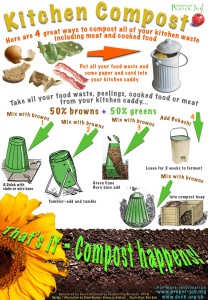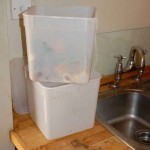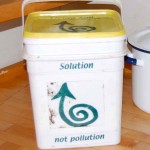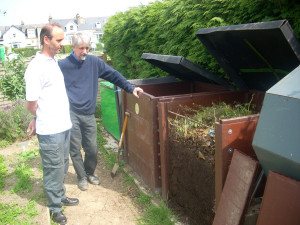Composting food waste (at home)
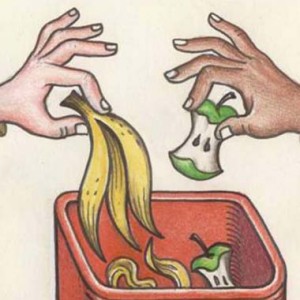 Of course the last thing you want to do is to compost food that could be eaten, so the first thing to do is to reduce food waste. But what do you with all those peelings and any leftovers that don’t get eaten?
Of course the last thing you want to do is to compost food that could be eaten, so the first thing to do is to reduce food waste. But what do you with all those peelings and any leftovers that don’t get eaten?
Composting food peelings and leftovers become a bit of a speciality for Devon Community Composting Network, especially in schools. This section explores some of the systems you can use for composting food waste on a household scale. For composting food waste on a larger scale, such as in a school or organisation visit the schools step by step composting page.
The secret of composting is getting the right balance of air and water. Food waste contains a very large proportion of water – banana peel is around 74% water! So the big task of composting food waste is to add dry, ‘brown’ materials that will absorb moisture and create air gaps. These include: woodchip, sawdust, shredded paper, cardboard, egg boxes. Paper and cardboard absorb and woodchip and tougher stems etc provide air spaces, ideally have both but the tougher air space materials are vital.
Air / Browns / Carbon Gallery
Water / Greens / Nitrogen Gallery
Composting raw food waste
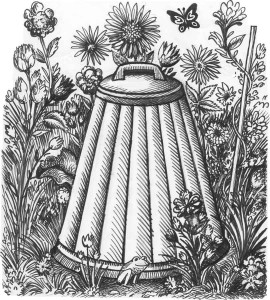
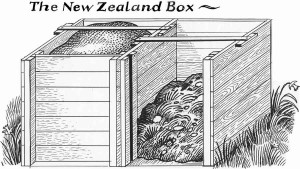 Raw food waste, such as vegetable peelings and outer leaves, is relatively easy to compost in a New Zealand box or Dalek bin so long as it is layered up with plenty of dry materials. It can also be layered in with garden waste materials.
Raw food waste, such as vegetable peelings and outer leaves, is relatively easy to compost in a New Zealand box or Dalek bin so long as it is layered up with plenty of dry materials. It can also be layered in with garden waste materials.
Overall aim for around half ‘wet’ materials and half ‘dry’. Every time food waste is added to the composter, level it out and add the same quantity of dry materials to cover the food waste. This will make sure there is a good balance of air and water, and will prevent flies smelling any fruit and being attracted to the compost.
Raw food waste can be composted in other systems such as a wormery or in a tumbler system which are explained below. Wormeries are particularly useful for households with limited space.
Composting cooked food waste at home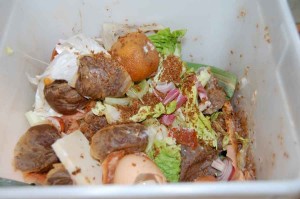
With the right equipment anyone can compost all food waste – whether fresh peelings, cooked food, meat, fish dairy – anything. To compost food waste successfully you either use a fermentation system such as Bokashi, a green cone composter or a small tumbling system, similar to the schools systems.
Bokashi
Bokashi, or effective mircro-organisms, is a system inved by professor Higa in Japan and utilises beneficial anaerobic microorganisms which have been used for centuries to ferment foods safely and without malodours. Bokashi has also been used by community groups – realising that residents on the high rise Nightingale estate in Hackney, London, had problems with blocked rubbish chutes which led to bad odour and infestations of flies, rats, ants and more. A community project started to collect food waste and cardboard weekly. The food waste had Bokashi sprinkled onto it by the householder and the result was 100% participation and elimination of the rat problem on the estate.
Its also a good system for householders wanting to compost food waste without attracting vermin and the resulting fermented food waste can be either buried in the garden or added to a dalek composter or similar. see the Living Soil website for more information
Green Cone
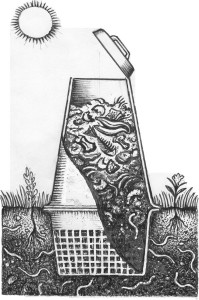 The Green cone comprises of a ‘washing basket’ buried in the ground with a double skinned cone on top. It is designed so that soil creatures, especially worms, will be attracted to feed on the materials and taken away into the surrounding soil. You have to set Green cones up carefully on level ground so that the seam between basket and top sections is level with the soil all round. they will last for several years in one spot but will eventually need moving.
The Green cone comprises of a ‘washing basket’ buried in the ground with a double skinned cone on top. It is designed so that soil creatures, especially worms, will be attracted to feed on the materials and taken away into the surrounding soil. You have to set Green cones up carefully on level ground so that the seam between basket and top sections is level with the soil all round. they will last for several years in one spot but will eventually need moving.
Wormeries
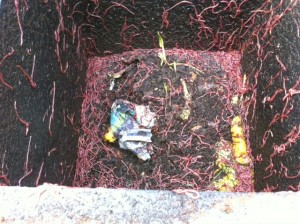 Worms can eat about half their own body weight a day if conditions are right they can only eat food that is soft and partially rotten. So if you have a kilo of worms you can feed them about half a kilo a day. To stop having festering food hanging about for ages this is why the schools food composting systems have two stages. A primary active tumbled or turned ‘hot’ phase and a longer cooler ‘maturation’ phase so the rather confusingly named HotBox becomes full of worms that move in during the cooler maturation phase. If you visit a Worm Farm you will see that they hot compost materials before spreading them out onto worm beds to finish off. However there are plenty of womeries on the market that you just dump food waste into and the worms will deal with it, albeit slower. The picture above is of my Hot Bin which is an extremely well insulated composter which keeps the heat in even in the cold weather. I find the worms love it too just as much as the HotBoxes. Most wormeries do not have this degree of insulation and so the worms low done and even stop eating in the coldest weather and for this reason some people site them in an outhouse or garage to keep warmer. The Proper Job project used to use old degassed chest freezers for the same reason. Wormeries are compact and can even be used by flat dwellers with a balcony, maybe not for all their food waste but at least for some of it. Of course in warmer countries you can compost a lot more in a small space and our friends at the Daily Dump in India (do have a look at their website its fab!) have developed decorative and functional composters for flat dwellers.
Worms can eat about half their own body weight a day if conditions are right they can only eat food that is soft and partially rotten. So if you have a kilo of worms you can feed them about half a kilo a day. To stop having festering food hanging about for ages this is why the schools food composting systems have two stages. A primary active tumbled or turned ‘hot’ phase and a longer cooler ‘maturation’ phase so the rather confusingly named HotBox becomes full of worms that move in during the cooler maturation phase. If you visit a Worm Farm you will see that they hot compost materials before spreading them out onto worm beds to finish off. However there are plenty of womeries on the market that you just dump food waste into and the worms will deal with it, albeit slower. The picture above is of my Hot Bin which is an extremely well insulated composter which keeps the heat in even in the cold weather. I find the worms love it too just as much as the HotBoxes. Most wormeries do not have this degree of insulation and so the worms low done and even stop eating in the coldest weather and for this reason some people site them in an outhouse or garage to keep warmer. The Proper Job project used to use old degassed chest freezers for the same reason. Wormeries are compact and can even be used by flat dwellers with a balcony, maybe not for all their food waste but at least for some of it. Of course in warmer countries you can compost a lot more in a small space and our friends at the Daily Dump in India (do have a look at their website its fab!) have developed decorative and functional composters for flat dwellers.
Tumbling or turning systems
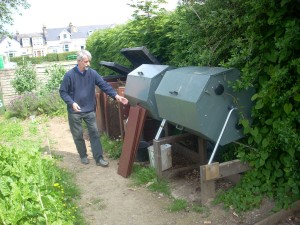 Most tumbling or turning systems are beyond the household budget although there are some simple barrel type ‘end over end’ systems which deal well with food waste and also pernicious weeds if used correctly. All these systems need to have a good source of wood chip or shavings etc to mix with the food waste. These are Jora 270 tumblers at a school used in conjunction with Scotty’s HotBox – see below
Most tumbling or turning systems are beyond the household budget although there are some simple barrel type ‘end over end’ systems which deal well with food waste and also pernicious weeds if used correctly. All these systems need to have a good source of wood chip or shavings etc to mix with the food waste. These are Jora 270 tumblers at a school used in conjunction with Scotty’s HotBox – see below
Scotty’s HotBox
Scotty’s HotBox was developed, designed and built by the brilliant and greatly missed Steve Ross-Smith at the sadly, now defunct, Worm Research Centre. in partnership with Nicky Scott under the Compost Doctors project. These bins were made in Devon and distributed by Proper Job (community business in Chagford Devon) Sadly since Brexit the costs in making them have risen so much that we have decided not to make them any more. These bins were designed to be rat proof and when used as maturation bins for the slow steady last phase of composting proved to be extremely robust and dependable. They were used for all compostables. The bins are generally used by schools and other institutions but Nicky has used one since they were developed for food waste and humanure composting for which they are ideal. For more on Humanure follow the link to Joe Jenkins site.









